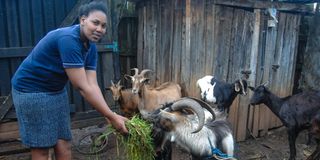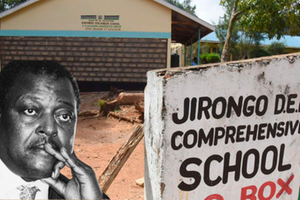Premium
Vet on call: Animal fractures and their remedies

Lucy Muthoni feeds her goats at Mastima estate in Elburgon, Nakuru County.
What you need to know:
- Modern farming methods, especially zero-grazing, have greatly increased the frequency of occurrence of fractures in livestock.
- Treatment of fractures requires the broken bones to be aligned in a process called fracture reduction. The bones are pulled and the broken ends made to touch each other end-to-end.
- The younger the animal the more appropriate it is to treat a fracture. Young animals have less muscle and weight compared to their body frames. Second, the animals are still growing fast in all body organs.
- Most fractures in animals raised under confinement are due to improper house construction.
A fracture is simply a break, usually in a bone in the body. In animals, it refers to a break in the bones of a live animal.
Modern farming methods, especially zero-grazing, have greatly increased the frequency of occurrence of fractures in livestock. In the past two weeks, I have dealt with three fractures in a cow, a calf and a goat.
The case of the cow and calf were reported on phone from Kakamega. The cow had a broken thigh bone or femur.
I advised the farmer to sell the animal for slaughter. In horses and cattle, we rarely consider treating fractures in adult animals.
Treatment of fractures requires the broken bones to be aligned in a process called fracture reduction. The bones are pulled and the broken ends made to touch each other end-to-end.
The doctor then uses available methods to keep the bones in the new position for periods of 6 to 8 weeks. This is called fixing of the fracture.
Due to the heavy weight and muscles of large adult animals like cattle and horses, fracture treatment in most cases is very expensive and often not viable.
The fracture in the calf was in the front leg between the carpal joint and the elbow. I advised the farmer to call a veterinary doctor close to her. She later confirmed the animal was recovering well after the fracture was treated with plaster of paris.
Plaster of paris is a surgical material made from gypsum and cotton gauze. It is often referred to as a plaster.
Less muscle and weight
Once it is wetted in warm water and exposed to air, it forms a paste that quickly dries and hardens like a soft rock to provide support and adequate fixation of the fracture.
This is the most common method of fracture treatment as it is easy for the doctor to execute and fairly cheap to the farmer.
The goat case was in Nairobi. Dorothy, the farmer, reported one of her dairy goats was found limping heavily in the morning and was carrying the left hind leg.
The term medically refers to the animal keeping the leg up folded at the heel and the knee. The previous night the goat had been fine. I asked her to isolate the animal in the sick pen awaiting my arrival.
I examined the animal on the farm and found there was a close to complete fracture on the leg midway between the hoof and heel joints.
The goat was about six months and, therefore, a good candidate for plaster fixation of the fracture using a plaster.
You see, the younger the animal the more appropriate it is to treat a fracture. Young animals have less muscle and weight compared to their body frames. Second, the animals are still growing fast in all body organs.
This makes the broken bone ends grow rapidly and seamlessly bridge the fracture gap. Dorothy’s case had good chances of recovery because the upper and lower bone pieces were not fully separated.
Therefore, the body would just produce new bone tissue to fill up the crack that had occurred in about three quarters of the bone circumference.
Improper house construction
I explained to Dorothy and James, her farm employee, the treatment I would give and the assistance I needed from them.
I tied the goat to a post in the sick pen and injected a calming medicine called a sedative to keep the goat still and relieve pain.
Fractures are extremely painful during treatment. I also gave an antibiotic injection to prevent bacterial infection and an anti-inflammatory to reduce swelling and tissue damage.
As James held the broken leg steady, I applied the plaster from just below the knee joint, over the heel joint and down past the hoof joint.
I only left the hoof peeping out of the cast. In fracture fixation, the doctor must stop all movement of the joint below and above the fracture so that the broken pieces remain close to each other end-to-end until they fuse to become a whole bone once again.
I explained to the farmer that the plaster must be kept dry all the time for the next six weeks. I would review and remove it then.
The last thing was to find out why the fracture had occurred. I noticed the gaps in the wooden raised floor were too big.
The goat most likely had got its foot caught in one of the gaps. We agreed she would reduce the gaps such that even the leg of a day-old kid could not slip through.
Most fractures in animals raised under confinement are due to improper house construction.





